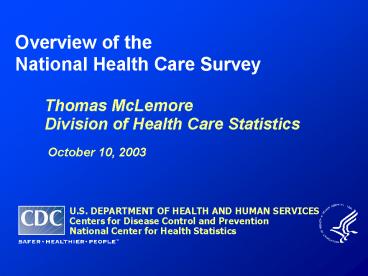Overview of the - PowerPoint PPT Presentation
1 / 25
Title:
Overview of the
Description:
Highlight new developments in the ambulatory, hospital, and long-term care surveys ... National Hospital Discharge Survey. Addition of data items on admission ... – PowerPoint PPT presentation
Number of Views:89
Avg rating:3.0/5.0
Title: Overview of the
1
Overview of the National Health Care Survey
Thomas McLemore Division of Health Care
Statistics October 10, 2003
2
Objectives
- Provide an overview of the NHCS
- Illustrate its value for characterizing the
health care delivery system - Highlight new developments in the ambulatory,
hospital, and long-term care surveys - Future challenges
3
National Health Care Survey
- Family of health care establishment and
provider-based surveys - Primary goal is to provide nationally
representative data on the use of health care
resources in the major sectors of the U.S. health
care delivery system
4
NHCS Component Surveys
- National Ambulatory Medical Care Survey
- National Hospital Ambulatory Medical Care Survey
- National Hospital Discharge Survey
- National Survey of Ambulatory Surgery
- National Nursing Home Survey
- National Home and Hospice Care Survey
5
Ambulatory Care Component
Years fielded
Sample size (approximate)
Survey
Type of data
National Visits to 1973-1981, 2,500-3,400 Ambulat
ory office-based 1985, 1989- physicians, Medical
Care physicians present 21,000- Survey
36,000 (NAMCS) encounters National
Visits to hospital 1992- 500 hospitals,
Hospital emergency and present 21,000-
Ambulatory outpatient 36,000 ED Medical
Care departments visits, Survey 27,000-
(NHAMCS) 35,000 OPD visits
6
Hospital and Surgical Care Component
Years fielded
Sample size (approximate)
Survey
Type of data
National Hospital 1965- 500 hospitals Hospital di
scharges present 300,000 Discharge discharges Su
rvey (NHDS) National Ambulatory
1994-1996 600 facilities
Survey of surgery
visits 125,000 Ambulatory discharges
Surgery (NSAS)
7
Long-term Care Component
Years fielded
Sample size (approximate)
Survey
Type of data
National Nursing home 1973-74, 1,100-1,900 Nursin
g characteristics, 1977, nursing homes, Home
Survey current 1985, 5,200-8,200 (NNHS)
residents, 1995, current residents discharges 1
997, 6,000-6,900 1999 discharges National
Home Agency 1992-1994, 1,100-1,800
and
Hospice characteristics 1996, agencies,
Care Survey current patients 1998, 3,400-5,400
(NHHCS) discharges 2000 current
patients, 3,000-4,900 discharges
8
Trends in Rates of Use of Health Care Services
Rate per 1,000 Population 65
1995- 96
1997- 98
1999- 2000
1985
1992
Office-based physician visits 4,848 5,455 5,495 6
,025 6,468 Outpatient department
visits 288.1 326.9 380.1 413.6 Emergency
department visits 411.7 432.9 470.1 489.4 Hospi
tal discharges 369.8 336.5 345.4 363.2 365.0 Nurs
ing Home current 46.2 42.8 43.4 42.9
residents Nursing Home discharges 38.2
62.2 65.1
Home Health
Agency 71.4 153.5 155.5 143.9
discharges Hospice discharges 4.9 7.9 11.1 14
.3
Data not collected during that time
period Denotes statistically significant trend
at the pNHAMCS, and NHDS rates for these years
9
NHCS Common Methodology
- National probability sample surveys
- Complex sample designs
- National and regional estimates
- Common definitions, data items, sampling frames
- Medical diagnoses
- Data collected by Census Bureau
- High response rates
- Data processed by private contractor
10
How are NHCS Data Used?
- To understand health care practice
- To identify and track specific conditions and
problems - To identify differences in the provision of
services - To establish national priorities
- To provide national comparative points
- To measure Healthy People objectives
11
Data Users
- Over 150 journal articles in last 2 years
- Other Federal agencies
- Health and medical professional associations
- State and federal policy makers
- Health services researchers
- Epidemiologists
- Universities and medical schools
- Broadcast and print media
12
Average Length of Stay by Age, 1970-2000
Days
65 years and over
45-64 years
15-44 years
Under 15 years
1970
1980
1990
2000
SOURCE NCHS/CDC, National Hospital Discharge
Survey
13
Hospice Patients and Discharges with Cancer as a
Primary Diagnosis at Admission
Percent
Discharges
Current patients
1992
1994
1996
1998
2000
SOURCE NCHS/CDC, National Home and Hospice Care
Surveys
14
(No Transcript)
15
(No Transcript)
16
(No Transcript)
17
(No Transcript)
18
(No Transcript)
19
Antibiotic Prescribing Rates at Physician Office
Visits for Children
Rate per 1000 population
Rate per 1000 visits
SOURCE NCHS/CDC, National Ambulatory Medical
Care Surveys
20
NHCS Data Dissemination
- Website
- www.cdc.gov/nchs/nhcs.htm
- NHCS and component survey websites
- Publications and information products
- Data warehouse
- CD/ROMs
- LISTSERVs
- Research Data Center
21
Drivers
- Increase relevance and timeliness of NHCS data
- Be more responsive to data needs for public
health, health services research, health policy,
and DHHS initiatives - Expand surveys to include the full spectrum of
health care providers (first step eliminate
major data gaps)
22
Recent Developments Ambulatory Care Component
- Supplement on ED pediatric services and equipment
- ED staffing and ambulance diversion
- Supplemental sample of rural and proprietary
hospitals - Bioterrorism preparedness items
23
Recent Developments National Hospital
Discharge Survey
- Addition of data items on admission type and
source - Creation of linked files (AHA and ARF) for trend
analysis - Ongoing research to evaluate the collection of
drug data
24
Recent Developments Long-term Care Component
- Redesign of the NNHS
- Conversion to CAPI data collection
- Development of expanded data content
- Linkage to the Minimum Data Set
- Collaborative effort to collect data on certified
nursing aides - Investigation of lists of long-term care
residential places - Ongoing research to develop a typology of LTC
facilities
25
Future Challenges
- Establishing priorities among the many competing
data needs and interests - Balancing data needs and respondent burden
- Developing new initiatives while maintaining
necessary trend data - Balancing public release of data with disclosure
risk - Resource management































